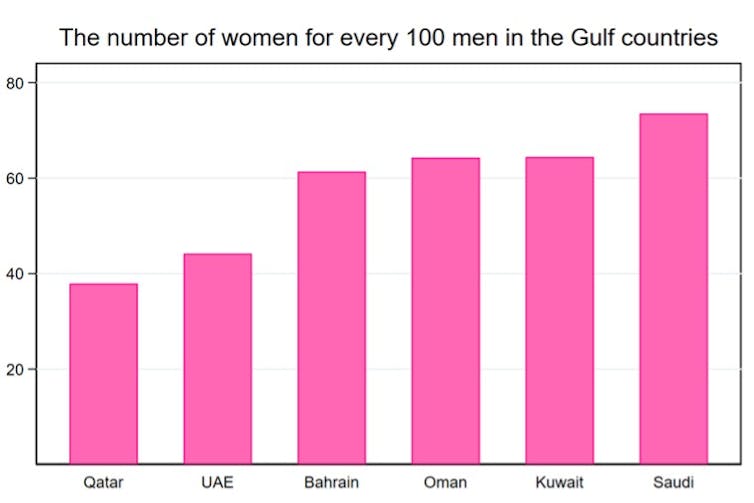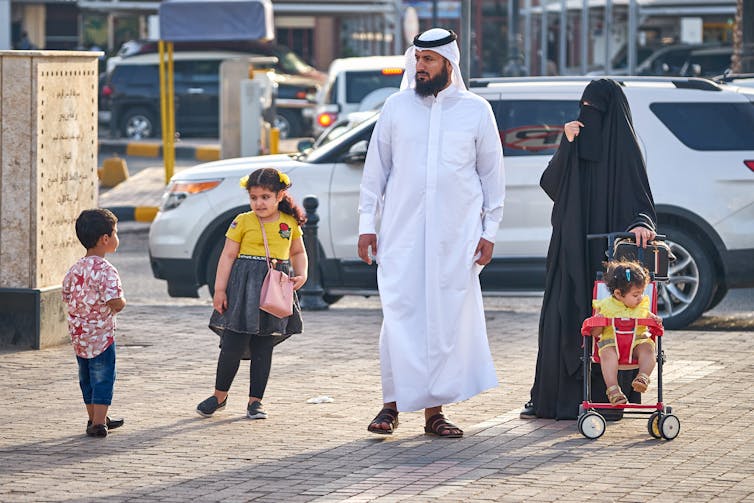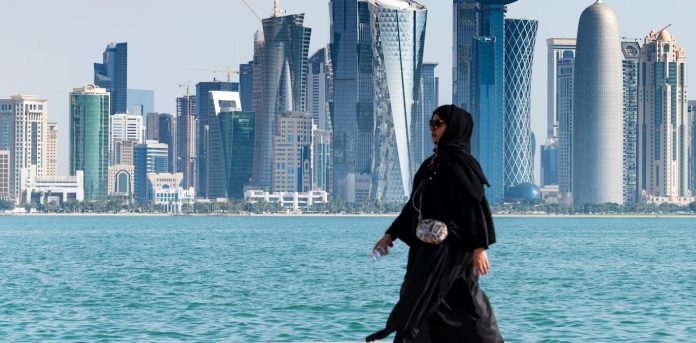There are 13 million women ‘missing’ in Gulf states – here’s why it is holding their economies back
Even though birthrates seem normal, with about 96 baby girls born for every 100 baby boys, a dramatic shift occurs in adulthood. For every 100 men in the Gulf, there are only 58 women. Qatar presents the most extreme case, with just 38 women per every 100 men.
This imbalance is caused primarily by an influx of workers from abroad. In certain Gulf states, foreign workers make up as much as 95% of the workforce, and most of these are men.
Nobel laureate and economist Amartya Sen developed the term “missing women” in 1990 to describe populations where women are demographically underrepresented. Our calculations, which use data from the World Bank on the global average gender ratio, suggest that approximately 13 million women are “missing” in total from the Gulf states.

The roots of this gender imbalance are deeply entangled in the region’s cultural traditions. Despite recent reforms, many Gulf countries still maintain guardianship laws that require women to obtain male permission for basic rights like getting married, launching certain types of business, or catching a flight.
On top of that, cultural norms often confine women to household duties, which severely limits their opportunities to get a job.
This is not to say no women manage to secure employment – 40% of working-age women in the Gulf currently have a job. However, those that are in employment often receive smaller salaries than their male colleagues, partly because they are not expected to be breadwinners.
Research has also found that in-work training remains largely inaccessible to women. Many employers in the region are reluctant to invest in women’s professional growth, fearing they may leave work for family reasons.
Holding their economies back
The economic cost of keeping millions of women out of the workplace is huge. One study from 2013 found that removing barriers to women’s employment could boost growth significantly in south Mediterranean countries.
A higher number of people in the workforce can make wages more competitive, which helps businesses sell their products abroad more easily. And having more people in work means more spending and greater business investment too.
Indeed, a report from 2015 by American consulting firm, McKinsey & Company, found that improving women’s equality could add an estimated US$600 billion (£459 billion) to annual GDP in the Middle East and North Africa region by 2025, compared with a business-as-usual scenario.
By sidelining educated women, Gulf economies are also depriving themselves of fresh insights crucial for diversifying beyond oil. Recent research on the Gulf region suggests that having more gender diversity in the workplace leads to better financial decisions.
And restricting female employment exacerbates the Gulf’s heavy reliance on foreign workers. Migrants send much of what they earn back home, representing a substantial drain on Gulf economies. According to the World Bank, remittances from Gulf states amounted to US$669 billion in 2023.

Despite the deep-rooted obstacles that woman face, change is on the horizon. The UAE, for example, has achieved gender equality at the parliamentary level. And Saudi Arabia lifted its longstanding driving ban on women in 2019, which should increase their mobility and potentially their job prospects too.
Several Gulf countries are appointing women to senior government positions, offering visible examples of female success. For instance, Shihana Alazzaz was appointed deputy secretary-general of the council of ministers in Saudi Arabia in 2022, becoming the first woman to hold the position.
And women in the Gulf are building a strong talent pipeline, as they currently make up the majority of university students in the region.
The judicial system is also evolving, with Bahrain and Qatar both allowing women to work as judges. And the private sector is introducing initiatives to empower women, as well as offering more flexible working options.
Economic necessity will arguably speed up the pace of change, as Gulf countries wrestle with the need to diversify their economies beyond oil. However, the entrenched cultural norms and lingering legal hurdles that continue to hinder women’s full economic engagement still render these advancements incomplete.

Bringing the missing women into the workforce requires a committed and comprehensive strategy. Legal reforms must dismantle the remaining guardianship laws and cement workplace safeguards. And education and training programmes need to align women’s skills with market demands, as well as providing targeted development opportunities.
A broader cultural shift is also essential, challenging traditional gender roles through the media, education and public dialogue. And workplace policies need upgrading, in order to incorporate family-friendly practices and transparent career advancement paths for women.
Economic incentives such as government grants or tax reliefs for firms achieving gender diversity targets could accelerate this shift.
The towering skylines of Gulf cities are a testament to rapid progress. Yet genuine advancement should not be measured in concrete and steel, but in the opportunities available to all citizens. The challenge now is to build economies that harness the talent of both sexes when driving innovation, growth and societal development.![]()
Amr Saber Algarhi, Senior Lecturer in Economics, Sheffield Hallam University and Konstantinos Lagos, Senior Lecturer in Business and Economics, Sheffield Hallam University
This article is republished from The Conversation under a Creative Commons license. Read the original article.



